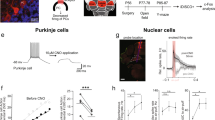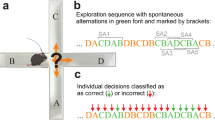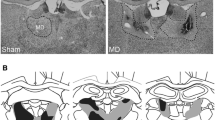Abstract
The influence of a hemicerebellar lesion on the exploration of environments with different spatial distributions of multiple rewards was analyzed. Hemicerebellectomized (HCbed) and intact rats were submitted to a search task in which they had to explore nine food trays in an open field, avoiding repeated visits. Trays were spatially arranged in four configurations: cross, 3 × 3 matrix, circle, and three clusters of three trays each. Lesioned and intact rats’ performances improved in all configurations used. However, the explorative activity of the HCbed animals differed from that of intact rats. Lesioned animals spent more time, made more errors, displayed lower search efficiency, exhibited shorter final spans, and traveled longer distances. They tended to perseverate and to neglect some trays. The cerebellar damage differentially influenced performances as a specific effect of the susceptibility of the configurations to being explored in a principled way. In the cross configuration that had strong spatial constraints, both groups made their lowest number of errors. In the circle configuration, the altered explorative strategies of lesioned animals made extremely demanding the acquisition of the task of searching multiple rewards, in spite of the attempt of favoring their altered procedures through an appropriate spatial arrangement. Since the procedural impairment elicited by cerebellar damage affected the central exploration, the matrix configuration was the most difficult configuration to be explored by the HCbed rats. The poor performances in the cluster configuration indicated that chunking was a strategy of relative strength in rats in general and in HCbed rats in particular.







Similar content being viewed by others
References
Petrosini L, Molinari M, Dell’Anna ME (1996) Cerebellar contribution to spatial event processing: Morris water maze and T-maze. Eur J Neurosci 8:1882–1896
Leggio MG, Neri P, Graziano A, Mandolesi L, Molinari M, Petrosini L (1999) Cerebellar contribution to spatial event processing: characterization of procedural learning. Exp Brain Res 127:1–11
Mandolesi L, Leggio MG, Graziano A, Neri P, Petrosini L (2001) Cerebellar contribution to spatial event processing: involvement in procedural and working memory components. Eur J Neurosci 14:2011–2022
Rondi-Reig L, Le Marec N, Caston J, Mariani J (2002) The role of climbing and parallel fibers inputs to cerebellar cortex in navigation. Behav Brain Res 132:11–18
Petrosini L, Leggio MG, Molinari M (1998) The cerebellum in the spatial problem solving: a co-star or a guest star? Progr Neurobiol 56:191–210
Mandolesi L, Leggio MG, Spirito F, Petrosini L (2003) Cerebellar contribution to spatial event processing: do spatial procedures contribute to formation of spatial declarative knowledge? Eur J Neurosci 18:2618–2626
Lalonde R, Botez MI, Boivin D (1987) Object exploration in staggerer mutant mice. Physiol Behav 41:115–117
Belzung C, Chapillon P, Lalonde R (2001) The effects of the lurcher mutation on object localization, T-maze discrimination, and radial arm maze tasks. Behav Genet 31:151–155
Lalonde R, Strazielle C (2003) The effects of cerebellar damage on maze learning in animals. Cerebellum 2:300–339
Lalonde R, Botez MI (1985) Exploration and habituation in nervous mutant mice. Behav Brain Res 17:83–86
Lalonde R (1987) Exploration and spatial learning in staggerer mutant mice. J Neurogenet 4:285–291
Lalonde R, Manseau M, Botez MI (1989) Exploration and habituation in Purkinje cell degeneration mutant mice. Brain Res 479:201–203
Lalonde R, Manseau M, Botez MI (1988) Spontaneous alternation and exploration in staggerer mutant mice. Behav Brain Res 27:273–276
Dahhaoui M, Caston J, Lannou J, Avenel S (1992) Role of the cerebellum in habituation exploration behavior in the rat. Physiol Behav 52:339–344
Joyal CC, Meyer C, Jacquart G, Mahler P, Caston J, Lalonde R (1996) Effects of midline and lateral cerebellar lesions on motor coordination and spatial orientation. Brain Res 739:1–11
Caston J, Chianale C, Delhaye-Bouchaud N, Mariani J (1998) Role of the cerebellum in exploration behavior. Brain Res 808:232–237
Foti F, Spirito F, Mandolesi L, Aversano M, Petrosini L (2007) Effects of spatial food distribution on search behavior in rats (Rattus norvegicus). J Comp Psychol 121:290–299
Molinari M, Petrosini L, Gremoli T (1990) Hemicerebellectomy and motor behaviour in rats. II. Effects of cerebellar lesion performed at different developmental stages. Exp Brain Res 82:483–492
Molinari M, Grammaldo LG, Petrosini L (1997) Cerebellar contribution to spatial event processing: right/left discrimination abilities in rats. Eur J Neurosci 9:1986–1992
Leggio MG, Molinari M, Neri P, Graziano A, Mandolesi L, Petrosini L (2000) Representation of actions in rats: the role of cerebellum in learning spatial performances by observation. Proc Natl Acad Sci U S A 97:2320–2325
Mandolesi L, Leggio MG, Spirito F, Federico F, Petrosini L (2007) Is the cerebellum involved in the visuo-locomotor associative learning? Behav Brain Res 184:47–56
Colombel C, Lalonde R, Caston J (2004) The effects of unilateral removal of the cerebellar hemispheres on spatial learning and memory in rats. Brain Res 1004:108–115
De Bartolo P, Mandolesi L, Federico F, Foti F, Cutuli D, Gelfo F et al (2009) Cerebellar involvement in cognitive flexibility. Neurobiol Learn Mem 92:310–317. doi:10.1016/j.nlm.2009.03.008
Mandolesi L, Foti F, Cutuli D, Laricchiuta D, Gelfo F, De Bartolo P, Petrosini L (2009) Features of sequential learning in hemicerebellectomized rats. J Neurosci Res. doi:10.1002/jnr.22220
De Lillo C, Visalberghi E, Aversano M (1997) The organization of exhaustive searches in a patchy space by capuchin monkeys (Cebus apella). J Comp Psychol 111:82–90
De Lillo C, Aversano M, Tuci E, Visalberghi E (1998) Spatial constraints and regulatory functions in monkeys’ (Cebus apella) search. J Comp Psychol 112:353–362
Valsecchi P, Bartolomucci A, Aversano M, Visalberghi E (2000) Learning to cope with two different food distributions: the performance of house mice (Mus musculus). J Comp Psychol 114:272–280
Etienne AS, Maurer R, Séguinot V (1996) Path integration in mammals and its interaction with visual landmarks. J Exp Biol 199:201–209
Biegler R (2000) Possible uses of path integration in animal navigation. Anim Learn Behav 28:257–277
Parron C, Save E (2004) Evidence for entorhinal and parietal cortices involvement in path integration in the rat. Exp Brain Res 159:349–359
Buzsaki G (2005) Theta rhythm of navigation: link between path integration and landmark navigation, episodic and semantic memory. Hippocampus 15:827–840
Paz-Villagran V, Save E, Poucet B (2006) Spatial discrimination of visually similar environments by hippocampal place cells in the presence of remote recalibrating landmarks. Eur J Neurosci 23:187–195
Werner S, Bock O, Timmann D (2009) The effect of cerebellar cortical degeneration on adaptive plasticity and movement control. Exp Brain Res 193:189–196
Shaikh AG, Meng H, Angelaki DE (2004) Multiple reference frames for motion in the primate cerebellum. J Neurosci 24:4491–4497
Yakusheva TA, Shaikh AG, Green AM, Blazquez PM, Dickman JD, Angelaki DE (2007) Purkinje cells in posterior cerebellar vermis encode motion in an inertial reference frame. Neuron 54:973–985
Yakusheva T, Blazquez PM, Angelaki DE (2008) Frequency-selective coding of translation and tilt in macaque cerebellar nodulus and uvula. J Neurosci 28:9997–10009
Terrace HS, McGonigle BO (1994) Memory and representation of serial order by children, monkeys, and pigeons. Curr Dir Psychol Sci 3:180–189
Macuda T, Roberts WA (1995) Further evidence for hierarchical chunking in rat spatial memory. J Exp Psychol Anim Behav Proc 21:20–32
Cohen J, Pardy S, Solway H, Graham H (2003) Chunking versus foraging search patterns by rats in the hierarchically baited radial maze. Anim Cogn 6:93–104
Schenk F, Contant B, Grobety MC (1990) Angle and directionality affect rat’s organization of visits, sequences and spatial learning in modular mazes. Learn Motiv 21:164–189
Martin LA, Escher T, Goldowitz D, Mittleman G (2004) A relationship between cerebellar Purkinje cells and spatial working memory demonstrated in a lurcher/chimera mouse model system. Genes Brain Behav 3:158–166
Caston J, Chianale C, Mariani J (2004) Spatial memory of heterozygous staggerer (Rora(+)/Rora(sg)) versus normal (Rora(+)/Rora(+)) mice during aging. Behav Genet 34:319–324
Geier CF, Garver KE, Luna B (2007) Circuitry underlying temporally extended spatial working memory. Neuroimage 35:904–915
Stoodley CJ, Schmahmann JD (2009) Functional topography in the human cerebellum: a meta-analysis of neuroimaging studies. Neuroimage 44:489–501
Schmahmann JD, Sherman JC (1998) The cerebellar cognitive affective syndrome. Brain 121:561–579
Bellebaum C, Daum I (2007) Cerebellar involvement in executive control. Cerebellum 6:184–192
Hauser MD (1999) Perseveration, inhibition and the prefrontal cortex: a new look. Curr Opin Neurobiol 9:214–222
McDonald RJ, King AL, Foong N, Rizos Z, Hong NS (2008) Neurotoxic lesions of the medial prefrontal cortex or medial striatum impair multiple-location place learning in the water task: evidence for neural structures with complementary roles in behavioural flexibility. Exp Brain Res 187:419–427
Schmahmann JD (2004) Disorders of the cerebellum: ataxia, dysmetria of thought, and the cerebellar cognitive affective syndrome. J Neuropsychiatry Clin Neurosci 16:367–378
El-Awar M, Kish S, Oscar-Berman M, Robitaile Y, Schut L, Freedman M (1991) Selective delayed alternation deficits in dominantly inherited olivopontocerebellar atrophy. Brain Cogn 16:121–129
Grafman J, Litvan I, Massaquoi S, Stewart M, Sirigu A, Hallett M (1992) Cognitive planning deficit in patient with cerebellar atrophy. Neurology 42:1493–1496
Apollonio IM, Grafman J, Schwartz MS, Massaquoi S, Hallett M (1993) Memory in patients with cerebellar degeneration. Neurology 43:1536–1544
Schmahmann JD, Sherman JC (1997) Cerebellar cognitive affective syndrome. Int Rev Neurobiol 41:433–440
Bower JM (2002) The organization of cerebellar cortical circuitry revisited: implications for functions. Ann NY Acad Sci 978:135–155
Botez-Marquard T, Bard C, Léveillé J, Botez MI (2001) A severe frontal–parietal lobe syndrome following cerebellar damage. Eur J Neurol 8:347–353
Author information
Authors and Affiliations
Corresponding author
Rights and permissions
About this article
Cite this article
Foti, F., Mandolesi, L., Cutuli, D. et al. Cerebellar Damage Loosens the Strategic Use of the Spatial Structure of the Search Space. Cerebellum 9, 29–41 (2010). https://doi.org/10.1007/s12311-009-0134-4
Published:
Issue Date:
DOI: https://doi.org/10.1007/s12311-009-0134-4




